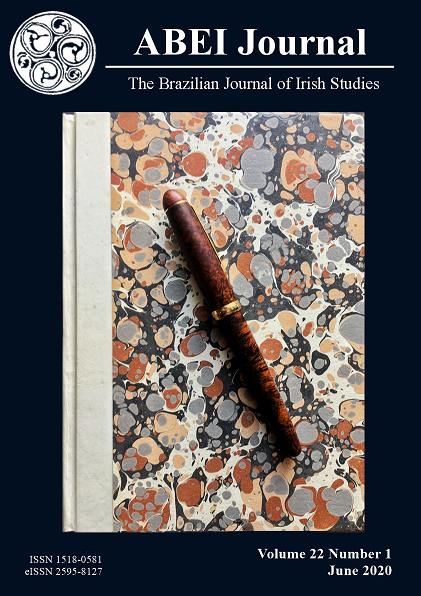Familiar/Familial Strangeness: The Place of Narration in John Banville’s Eclipse and The Sea and Mike McCormack’s Solar Bones
DOI:
https://doi.org/10.37389/abei.v22i1.3848Palabras clave:
Memory, identity, the house, defamiliarisation, places of narrationResumen
The trope of returning back to the childhood home, in middle age, after some kind of tragedy has struck is central to both the plot and act of narration in John Banville’s Eclipse (2000) and The Sea (2005). This withdrawal to the past is not simply a thematic element, but also a narrative strategy through which Banville casts an indirect gaze at the world as he describes it. Reality is, thus, never what is simply before your eyes but layered with echoes of the past, more specifically what we remember or imagine to be the past. The return home is also central to Mike McCormack’s Solar Bones (2016), in which Marcus Conway, the ghost-narrator finds himself back at his kitchen table where he reminisces about the past. What unites these novels is the act of narration, or the act of writing, that is carried out in these childhood spaces and places that are key to the ways in which these protagonists understand and confront their sense of identity although this notion of return is met with resistance or not fully understood by oneself. Extending this idea of what the house could symbolize in the context of Banville’s artistic aims, I examine the relationship between past and present, the act of writing for an imagined audience in one's childhood home, and how the spatial dimensions of the house itself relate to or reveal the aesthetics of these novels. Mike McCormack, whose writing has recently gained increasing critical attention, is one Irish author who makes an interesting counterpoint to Banville, in that similar concerns about identity and memory are reflected in the space of the home but in markedly different ways. This essay, hence, will demonstrate certain commonalities between these three novels while distinguishing how each engages with representations of space and place, particularly in the context of identity and the idea of home.
Referencias
Bachelard, Gaston. The Poetics of Space. Translated by Maria Jolas, Beacon Press, 1994.
Banville, John. Eclipse. Picador, 2000.
---. The Sea. Vintage Books, 2006.
---. “The Evidential Artist: A Conversation with John Banville.” By Aurora Piñeiro. Nordic Irish Studies, Vol. 14 (2015), pp. 55-69. Accessed 15 November 2019.
D’Hoker, Elke, Visions of Alterity. Rodopi, 2004.
---. “Self-Consciousness, Solipsism, and Storytelling: John Banville's Debt to Samuel Beckett.” Irish University Review, Vol. 36, No. 1, Special Issue: John Banville (Spring - Summer, 2006), pp. 68-80. Accessed 15 November 2019.
Gordon, Avery F.. Ghostly Matters: Haunting and the Sociological Imagination. University of Minnesota Press, 2008.
Hand, Derek. John Banville: Exploring Fictions. The Liffey Press. 2002.
McCormack, Mike. Solar Bones. Canongate, 2017.
---. “‘…a tiny part of that greater circum-terrestrial grid’: A Conversation with Mike McCormack.” By Treasa De Loughry. Irish University Review: A Journal of Irish Studies Food, Energy, Climate: Irish Culture and World-Ecology. Special Issue Spring/Summer 2019. Edinburgh University Press. pp. 105-116.
McMinn, Joseph. John Banville: A Critical Study. Gill and Macmillan, 1991.
---. The Supreme Fictions of John Banville. Manchester University Press, 1999.
Murphy, Neil. “From ‘Long Lankin’ to ‘Birchwood’: The Genesis of John Banville’s Architectural Space.” Irish University Review, Vol. 36, No. 1, Special Issue: John Banville (Spring – Summer 2006). Accessed 3 November 2014.
---. John Banville. Bucknell University Press, 2018.
Powell, Kersti Tarien. “The Lighted Windows: Place in John Banville’s Novels.” Irish University Review, Vol. 36, No. 1, Special Issue: John Banville (Spring – Summer, 2006). pp. 39-51. Accessed 15 November 2019.
Richardson, Brian. Unnatural Voices: Extreme Narration in Modern and Contemporary Fiction. The Ohio State University Press, 2006.
Ryan, Marie-Laure. “Impossible worlds.” The Routledge Companion to Experimental Literature, edited by Joe Bray, Alison Gibbons and Brian McHale, Routledge, 2012.
Smith, Eoghan. John Banville: Art and Authenticity. Peter Lang, 2013.
Wilkinson, Robin. “Echo and Coincidence in John Banville's Eclipse”. Irish University Review, Vol. 33, No. 2 (Autumn - Winter, 2003), pp. 356-370. Accessed 15 November 2019.
Wylie, Donovan, and Martin Secker & Warburg, ‘Wexford’, 32 Counties – Photographs of Ireland. London, 1989, p. 200.
“Oblique Dreamer: Interview with John Banville.” The Observer (17 September 2000), https://www.theguardian.com/books/2000/sep/17/fiction.johnbanville. Accessed December 3, 2019.
Descargas
Publicado
Número
Sección
Licencia
Derechos de autor 2020 Adel Cheong

Esta obra está bajo una licencia internacional Creative Commons Atribución-NoComercial 4.0.


